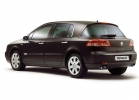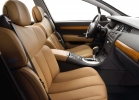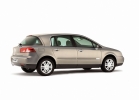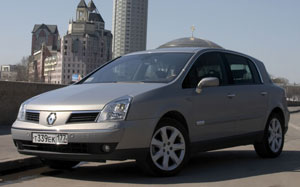Test drive by Renault Vel Satis since 2005 hatchback
The situation obliges
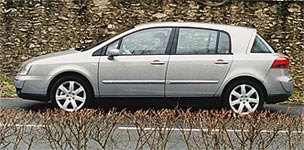 The French address their new brainchild to those who combine high cultural level with the breadth of views and freedom.
The French address their new brainchild to those who combine high cultural level with the breadth of views and freedom. Preparation of public opinion
Lux is now in fashion, which means it is well sold! The smell of money is stupefying not only recognized luxury suppliers, but also those companies whose business card has always been mass products. Renault - from their number. The status of one of the oldest and largest in the world dictated and its presence in the upper middle class. But kinship with practical and compact models appeared too clearly to perceive large Renault as prestigious.
Meanwhile, the affairs of the company went uphill, the positions in the markets were strong. The need to adequately crown the model range became more and more obvious. And in the mid-90s, the concept of initialsyal appeared, and in Paris in the fall of the 98th-another concept, Vel-satis. In the spring of 2000, Vel-Satis was already presented as prepared for production, and after another year a commercial premiere took place.
The thorough preparation of public opinion is justified: after all, Vel-Satis largely contradicts the idea of \u200b\u200ba prestigious machine as a large sedan. The creators prefer to call it a high sedan, emphasizing that the body is 13 cm higher than that of such a car of classic proportions. Hence the more natural, free, convenient planting - first of all, passengers of the rear seat. There is no doubt that many owners of Vel Satis have no doubt - the situation obliges! Nevertheless, the designers paid tribute to the principle of universality: the rear seat is folding in parts, and the back door opens up access that you, gentlemen, what a hatchback: this is a high sedan!
 High sedan outside and inside
High sedan outside and inside But the driver does not at all feel deprived - neither expanse nor the ability to choose a comfortable landing, nor in the convenience of work. Unusually massive front chairs seemed to be transferred here from cabinet silence. However, the home interior is far from such sophistication: each chair has five adjustments (including the inclination of the upper and lower parts of the back - separately!). Everything seems to be done so that the driver and passenger of any complexion find the most convenient pose. The chair will remember her, and the safety belts built into the backs will be fixed unobtrusively.
For acquaintance, we were provided with Vel Satis with the most powerful engines, diesel and gasoline, in the richest of three initiations incuel. I admit, the interior, designed in dark colors, seemed rustic, and wood inserts - too contrasting. The next day, finding himself in the kingdom of light shades, I did not recognize the salon: before that harmoniously and comfortable! The design is undoubtedly modern, but, fortunately, deprived of deliberate avant -garde. On the contrary: round dials of instruments (and even hours!) With a pleasant pale lilac backlight, as if remind of an era when all the sedans were tall and the engine start button on the instrument panel-for someone well forgotten old.
However, historical parallels are deceiving: before clicking the start, you will need to insert an electronic card into a slot. She, as you guessed, unlocks the car and removes the guard. Having done all this, we will go on the road.
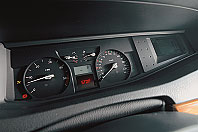
Devices are easily read and pleasantly lit
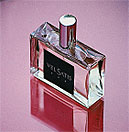
The aroma is not for the owner, but ... for the salon
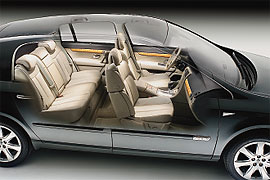 Modularity of the status
Modularity of the status Europe, as you know, honors not only memory, but also the engine engine, and France is perhaps the best example of this. The phrase the prestigious diesel car does not cut a rumor here-like us, who arranged in the Vel-Satis-3,0DCI salon, did not cut the sound of a three-liter 180-horsepower turbodiesel. The motor with a five-speed automatic machine made up a beautiful pair: the partner-clock quickly and accurately responded to all the engine commands, to change his mood. Moreover, both acted softly and silently, trying not to attract the attention of passengers.
Having decided to rest, we got out of the cabin - and found that in idle diesel, the sound was by no means a prestigious level and Tembrah - we coped with the inner noise, and there, you look, they would overcome the external one.
The gasoline engine (3.5 l; 245 h.) His holes: it spins faster - and therefore, more intensively accelerates the machine. But I do not advise those who appreciate the silence in the cabin to abuse these qualities: high turns accompanying a rather sharp sound. It is more reasonable to show moderation that befell the status and size of the car, and the pocket (power), as you know, does not pull.
There are more democratic options: with a 2-liter gasoline engine, as well as 2.2-liter turbodiesels such as the Common Rail (115 or 150 hp). These 4 -cylinder engines can be combined with a six -speed hand gearbox, and a weak gasoline - only with it.
 Careful electronics and cunning mechanics
Careful electronics and cunning mechanics At high speed, an aerodynamic noise is noticeable (but not annoying) - a kind of fee for getting rid of other sounds. In the end, something should remind of speed! The transverse buildup on irregularities is also noticeable - this is how the unimportant quality of the coating makes itself felt. And also - the paroor manifested by gusts of the side wind and the trips with the wagons: the side of the sidewall is large, the center of the masses is somewhat raised. Both - reasons to once again call for moderation. Although someone, in fact, call: a wealthy fan of fast driving, apparently, will prefer a model with a driver’s accent, and the personalist will not bother the owner with sharp maneuvers.
Moreover, numerous electronic assistants insure the driver himself: the steering hydraulic power steering, the resistance on which grows with an increase in speed, ABS, a dynamic control system, an emergency braking device, tire pressure control and even automatic parking brake. The touch of touching the handbrake became not needed, and the lever between the seats was taken by an immense box. Vel-satis and cruise control that can change the speed depending on the intensity of the flow, and parking sensors-however, his hints are too delicate. Although it is very necessary: \u200b\u200bthe car is large, its shape is unusual, and the extreme points are not visible.
By the way: in order to improve the review in bad weather, they tried to expand the wiper cleaning area. They move not in parallel, but towards, reaching the edges of the huge glass, and the brushes themselves are elastic, without a frame.
If the driver nevertheless made a fatal mistake, the entire arsenal of passive safety funds will enter into business - from belts and headrests, inflatable pillows and curtains to energy -absorbing body zones. In case of a blow with a low speed (up to 15 km/h) there is a trick: the crossbars of the body are made with a high limit of elasticity, which will reduce the cost of repairs.
Aluminum hood and side doors, as well as the back door from the composite, are unlikely to reduce the repairs, but they will flatter the pride of the advanced owner involvement in high technologies.
How much will non -conformism cost?
However, all the technical tricks used by French engineers can be unclaimed if the buyers, as they say, do not peck at unusual forms and proportions of the vel-satis. So far, marketers and designers of Renault are full of optimism (I quote the press release of the company): there is an influx of customers who are not so passionate about conformism, who gradually depart from the classic sedan, preferring luxurious universals, convertibles or non-combatants in the consumer addictions of such customers, a great breadth of views are expressed, Cultural level and freedom. So that.
Non-conformism and the search for your own style will cost a European of 30-47 thousand euros. As for Russia, where Vel Satis will appear closer to autumn, it seems that here its technique will depend not only on the breadth of views, but also on the non -informative (simply reasonable) price. Until now, Renault followed just such a policy - will there be something this time?
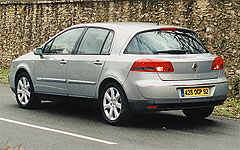
In this perspective, as, indeed, in front, Vel-Satis is easily recognizable

Fashionable little thing: emblem-zoom
Renault Val Satis 3.5v6 (3.0 DCI)
common data
Body
5-seater sedan
Equipped mass, kg
1720 (1735)
Complete mass, kg
2270 (2320)
Length x width x height, mm
4860 x 1860 x 1577
Wheel base, mm
2840
Front/back, mm track
1575/1550
Maximum speed, km/h
235 (210)
Acceleration 0100 km/h, with
8.5 (10.7)
Fuel consumption, l/100 km
11.5 (8.7)
Fuel supply, l
80
Engine
Location
Front transversely
Design
6-cylinder, V-shaped, with four upper
distribution shafts
The number of valves per cylinder
four
Cylinder diameter /piston stroke, mm
95.5x81.4 (87.5x82)
Working volume, SMZ
3498 (2958)
Power, L.S. (kW) at rpm
245/6000 (180/4400)
Torque, kgsm (nm) at rpm
34.3/3600 (36.4/1800)
Chassis
Transmission
front -wheel drive
Transmission
5-speed automatic
Suspension:
front
Independent, such as McEferson
behind
Independent multi -link, spring type trigon
Steering
REMENCH with an amplifier
Brakes:
Hydraulic disk (ventilated in front)
with a vacuum amplifier, ABS,
Break Essist and traction control system
The size of the tires
255/55 R17 W or 245/45 R18 W
Vladimir Arkush, photo Vladimir Arkush and Renault
Source: Magazine "Limousine" [03/02]
Video test drives Renault Vel Satis since 2005
Renault Vel Satis Crash Video since 2005
Test drive by Renault Vel Satis since 2005
Renault Vel Satis Crash Test since 2005
Krassh Test: Detailed Information34%
Driver and passengers
2%
Pedestrians

